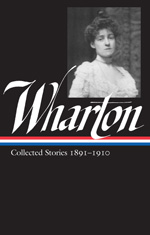From Edith Wharton: Collected Stories 1891–1910
Interesting Links
“The Grandest Grande Dame” (Hilary Spurling, The Guardian)
Remarks on Edith Wharton’s Collected Stories by editor Maureen Howard (Library of America)
Previous Story of the Week selections
• “The Fulness of Life,” Edith Wharton
• “Going to Shrewsbury.” Sarah Orne Jewett
• “The Mourners,” Bernard Malamud
• “Agatha,” John O’Hara
Buy the book
 Edith Wharton: Collected Stories 1891–1910
Edith Wharton: Collected Stories 1891–1910
Two novellas: The Touchstone and Sanctuary | 36 stories | 928 pages
List price: $40.00
Save 20%
Web store price: $31.50
Save $25 when you buy both volumes of Edith Wharton’s stories.
“The Grandest Grande Dame” (Hilary Spurling, The Guardian)
Remarks on Edith Wharton’s Collected Stories by editor Maureen Howard (Library of America)
Previous Story of the Week selections
• “The Fulness of Life,” Edith Wharton
• “Going to Shrewsbury.” Sarah Orne Jewett
• “The Mourners,” Bernard Malamud
• “Agatha,” John O’Hara
Buy the book
 Edith Wharton: Collected Stories 1891–1910
Edith Wharton: Collected Stories 1891–1910Two novellas: The Touchstone and Sanctuary | 36 stories | 928 pages
List price: $40.00
Save 20%
Web store price: $31.50
Save $25 when you buy both volumes of Edith Wharton’s stories.
It would be nine years before a few more poems appeared, between 1889 and 1891, in Scribner’s Magazine. She would publish her first story, “Mrs. Manstey’s View,” there when she was twenty-nine. It was another seven years before her first book publication, and eight years before her first volume of stories, marking the true beginning, at the age of thirty-seven, of her thereafter unstoppable professional career.What “happened,” in part, was courtship, two engagements, and eventually marriage—an unhappy one at that. Her first engagement was broken off because, according to a gossip piece in a local society paper, her prospective mother-in-law worried that she was “an ambitious authoress”—that there was “an alleged preponderance of intellectuality on the part of the intended bride.” Three years later she would instead marry Edward Wharton. “It was, eventually, greatly to Wharton’s benefit that she had to perform, for years, not as a young writer, but as a young debutante, socialite and wife, in a period of dramatic social change,” Lee argues. “Whatever her private frustrations, she missed nothing of what was going on around her, and would use everything.”
And so, like many women writers of the era, Edith Wharton truly began her career as a full-time author relatively late in life. Her first novel, The Valley of Decision, appeared in 1902, when she was forty, and sold a remarkable 25,000 copies. During her last four decades she would publish fifteen novels, nine novellas, nine books of nonfiction, and more than eighty short stories.
In her earliest stories Wharton wrote about America’s underprivileged residents rather than the portraits of the upper crust that readers would come to expect from her. This vein of fiction culminated in the bleak realism of the largely overlooked novella “Bunner Sisters”; numerous critics and scholars since the days of Edmund Wilson and Irving Howe have touted it as unjustly neglected gem. “Wharton's strong strand of compassionate realism—more Dreiser than James—has tended to be undervalued,” writes Lee, who agrees that “Bunner Sisters,” is a “subdued, realist masterpiece.”
Although it would not be published until 1916 (Scribner’s rejected it twice), Wharton wrote “Bunner Sisters” in 1892—just two years after the appearance of her first published story, “Mrs. Manstey’s View,” which portrays a lonely widow living on the third floor of a New York boarding house. “Perhaps at heart Mrs. Manstey was an artist,” writes Wharton as she describes her protagonist’s delight in the flora and the humanity of the ramshackle neighborhood seen from her window—a pleasure threatened by planned construction in the neighboring yard. “The problems of Mrs. Manstey’s penurious life seem at a far remove from those of Mrs. Edward Wharton (fashionable East Side resident),” notes Cynthia Griffin Woolf, in a reappraisal that considers the possible autobiographical roots of the story. “It is not a difficult leap to move from this portrait of diminished existence to the life of a woman who had begun to write after so long a silence.”
Note: Quintus Curtius was a Roman historian, probably of the first century, who wrote De Rebus Gestis Alexandri Magni, a ten-book life of Alexander the Great. Wharton compares the condition of the tenement yards to the condition of the remnants of his work; the surviving text begins with book 3 and has gaps between books 5 and 6 and in book 10.
* * *
The view from Mrs. Manstey’s window was not a striking one, but to her at least it was full of interest and beauty. . . . If you don't see the full selection below, click here (PDF) or click here (Google Docs) to read it—free!This selection may be photocopied and distributed for classroom or educational use.
